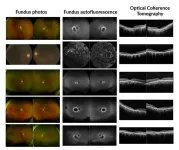(Press-News.org) The number of days per year that are simultaneously extremely hot, dry, and have a high fire risk have as much as tripled since 1970 in some parts of South America. The results are published in a study in Communications Earth & Environment.
South America is warming at a similar rate to the global average. However, some regions of the subcontinent are more at risk of the co-occurrence of multiple climate extremes. These compound extremes can have amplified impacts on ecosystems, economy, and human health.
Raúl Cordero and colleagues calculated the number of days per year that each approximately 30 by 30 km grid cell on the South American continent experienced simultaneous hot, dry, and flammable extremes between 1971–2022. Extremes for each condition were calculated from daily maximum temperature records, 30-day rainfall averages, and daily fire weather index records. The authors found that the frequency of these simultaneous extremes had increased across the entire continent. There were particularly high increases — from fewer than 20, to as many as 70 days per year — around the Venezuela–Colombia border, in the northern Amazon, and in the north of the Río de la Plata basin in central South America. The authors also found that there was an increase in the variability of these simultaneous events from year to year over the past five decades.
The authors additionally found that the likelihood of the compound conditions occurring on a regional basis was affected by the El Niño-Southern Oscillation. During the warm El Niño phase, fire risk increased in the northern Amazon region, whilst the cooler La Niña phase led to increased fire risk in central South America.
The authors caution that increased fire activity and dry extremes are both a public health hazard and can cause further warming through the release of black carbon to the atmosphere. They also highlight that these extreme events disproportionally affect vulnerable rural and indigenous populations, and suggest that policymakers in the region should have a greater focus on mitigating these extremes.
***
Springer Nature is committed to boosting the visibility of the UN Sustainable Development Goals and relevant information and evidence published in our journals and books. The research described in this press release pertains to SDG 13 (Climate Action). More information can be found here.
END
Climate change: Heat, drought, and fire risk increasing in South America
2024-09-26
ELSE PRESS RELEASES FROM THIS DATE:
Rates of sudden unexpected infant death before and during the pandemic
2024-09-26
About The Study: This cross-sectional study found increased rates of both sudden unexpected infant death (SUID) and sudden infant death syndrome (SIDS) during the COVID-19 pandemic, with a significant shift in epidemiology from the pre-pandemic period noted in June to December 2021. These findings support the hypothesis that off-season resurgences in endemic infectious pathogens may be associated with SUID rates, with respiratory syncytial virus (RSV) rates in the U.S. closely approximating this shift. Further investigation into the role ...
Estimation of tax benefit of nonprofit hospitals
2024-09-26
About The Study: This study highlights the wide variation of nonprofit hospitals’ tax benefit across states, its high concentration among a small number of hospitals, and the primary role played by state and local taxes. Policy efforts to strengthen nonprofit hospitals’ taxpayer accountability are likely to be more effective when pursued at the local level.
Corresponding Author: To contact the corresponding author, Ge Bai, PhD, CPA, email gbai@jhu.edu.
To access the embargoed study: Visit our For The Media ...
Scientists discover gene responsible for rare, inherited eye disease
2024-09-26
Scientists at the National Institutes of Health (NIH) and their colleagues have identified a gene responsible for some inherited retinal diseases (IRDs), which are a group of disorders that damage the eye’s light-sensing retina and threatens vision. Though IRDs affect more than 2 million people worldwide, each individual disease is rare, complicating efforts to identify enough people to study and conduct clinical trials to develop treatment. The study’s findings published today in JAMA Ophthalmology.
In a small study of six unrelated participants, researchers linked the gene UBAP1L to different forms of ...
Scientists discover "pause button" in human development
2024-09-26
In some mammals, the timing of the normally continuous embryonic development can be altered to improve the chances of survival for both the embryo and the mother. This mechanism to temporarily slow development, called embryonic diapause, often happens at the blastocyst stage, just before the embryo implants in the uterus. During diapause, the embryo remains free-floating and pregnancy is extended. This dormant state can be maintained for weeks or months before development is resumed, when conditions are favorable. Although not all mammals use this reproductive ...
Replica symmetry breaking in 1D Rayleigh scattering system: Theory and validations
2024-09-26
In both the natural world and human society, there commonly exist complex systems such as climate systems, ecological systems, and network systems. Due to the involvement of numerous interacting elements, complex systems can stay in multiple different states, and their overall behavior generally exhibits randomness and high disorder. For example, due to the complex interactions between factors such as solar radiation, terrain, and ocean currents, the climate system can exhibit various states like sunny, cloudy, and rainy. The dynamic changes and mutual influences of these factors make the behavior of the climate highly uncertain and difficult to predict accurately. For instance, the formation ...
New research identifies strong link between childhood opportunities and educational attainment and earnings as a young adult
2024-09-26
Washington, September 26, 2024—The number of educational opportunities that children accrue at home, in early education and care, at school, in afterschool programs, and in their communities as they grow up are strongly linked to their educational attainment and earnings in early adulthood, according to new research. The results indicate that the large opportunity gaps between low- and high-income households from birth through the end of high school largely explain differences in educational and income achievement ...
Statement by NIH on research misconduct findings
2024-09-26
EMBARGOED FOR RELEASE
Thursday, September 26, 2024 - 9 a.m. EDT
Contact:
NIH Office of Communications and Public Liaison
NIH News Media Branch
301-496-5787
Statement by NIH on Research Misconduct Findings
Following an investigation, the National Institutes of Health (NIH) has made findings of research misconduct against Eliezer Masliah, M.D., due to falsification and/or fabrication involving re-use and relabel of figure panels representing different experimental results in two publications. NIH will notify the two journals of its findings so that appropriate action can be taken. NIH initiated its research misconduct review process ...
Pregnant women who sleep less than 7 hours a night may have children with developmental delays
2024-09-26
WASHINGTON—Pregnant women who do not get enough sleep may be at higher risk of having children with neurodevelopmental delays, according to new research published in the Endocrine Society’s Journal of Clinical Endocrinology & Metabolism.
Short sleep duration (SSD) is defined as sleeping less than seven hours per night. Pregnant woman may have trouble sleeping due to hormonal changes, pregnancy discomfort, frequent urination, and other factors.
It’s been reported that almost 40% of pregnant women have SSD. These women may have ...
ESO telescope captures the most detailed infrared map ever of our Milky Way
2024-09-26
Astronomers have published a gigantic infrared map of the Milky Way containing more than 1.5 billion objects ― the most detailed one ever made. Using the European Southern Observatory’s VISTA telescope, the team monitored the central regions of our Galaxy over more than 13 years. At 500 terabytes of data, this is the largest observational project ever carried out with an ESO telescope.
“We made so many discoveries, we have changed the view of our Galaxy forever,” says Dante Minniti, ...
An edible toothpaste-based transistor
2024-09-26
Milan (Italy), 26 September 2024 - A toothpaste-based transistor is the latest innovation from the research team at the Istituto Italiano di Tecnologia (IIT-Italian Institute of Technology) in Milan, which pushes the boundaries of edible electronics. This innovative nano-device is expected to become a key component of future smart pills, designed to monitor health conditions from within the body and then safely dissolve after completing their function. The research findings have been published in the journal Advanced Science.
Several commercial toothpaste formulations contain crystals of copper phthalocyanine, a blue pigment that acts as a whitening ...




